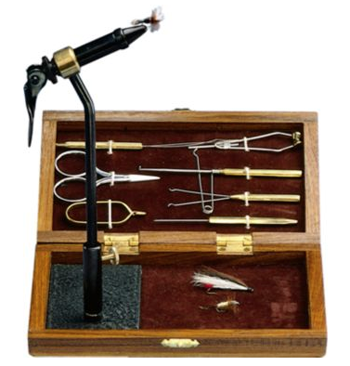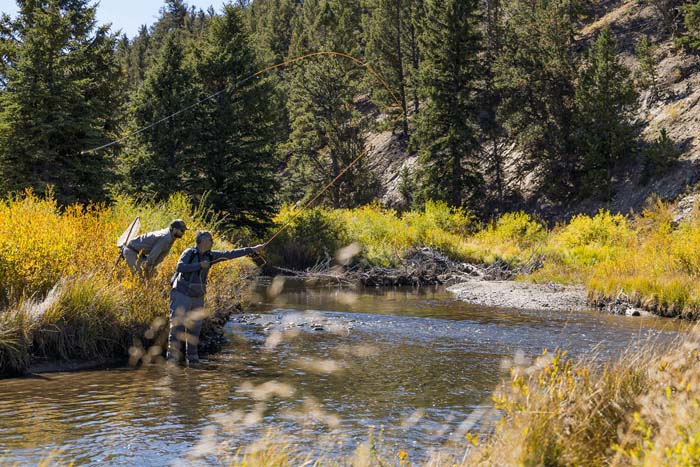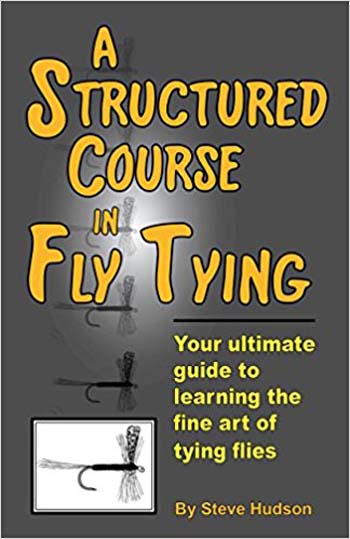Portable fly tying kits are not the next great thing. Sorry, there won’t be A Fly Tying Kit Runs Through It movie
By Skip Clement
[dropcap]I[/dropcap] cannot think of a lot of reasons, and in fact any, to carry a portable fly tying kit on a skiff. But in my truck? Always. Destination trips involving air travel? Cumbersome, but certainly doable.
I’ve had run-ins with fly tying kits: gifts for grandkids, nieces, nephews, and friends wanting to try fly tying, as well as, for my use.

Cabela’s Standard Fly Tying Tool Kit $35 + tax and shipping.
There are several orientations to these tying kits: toolkit only, bare minimum toolkit, materials only tying instructions kits, and various combinations of kits made up of versions of all of the latter. The pricing runs from about sub-$40 to a few hundred bucks. The constants in most of the kits are missing essential tools, like a whip finisher, for example, and poor quality tools – especially the vise.
Don’t get my direction wrong. These cheap tying kits are perfect for beginners. The best buy for any entry level would be a “complete” toolkit only – no materials. To launch with the best possible results to meet your expectations, think in terms of sub-$100 total investment.
Your second purchase, within the $100 consideration, is probably the most important if you want to get good right away and enjoy tying. It’s a book titled A Structured Course in Fly Tying, by Steve Hudson. It will let you in on the secrets of how to do everything. Your professor/author is actually both in real life with over 20 titles to his name and former English Department at Georgia State in Atlanta… he’s worth listening to.
He’s an expert tyer who can remember what the uh, oh spots are in the learning curve, and there are many. Hudson’s book is advertised as a beginner book, but it’s more a fly tyers bible. “Everything” is explained, perfectly. Every step… even the most advanced tying tricks are in the book. Gobble up its 200 step by step pages and you can tie anything.
Some major brand names can be found in the portable tying kit market, but not one of the “biggies” is all in, which may be due to the fact of low profitability, or just not that much interest.
My phone calls to a few high profile “fly fishing” oriented companies about their “kits” or lack thereof, were met with: well, er, ah, um, we working on that, we have this…, and I’ll get back to you on that.
I asked around about portable tying kits and got only one response. Angie Roth, my retired lawyer friend was okay with the lower quality tools. Adding they did the job, and smaller than regular tools made them easy to pack/store and not cause $ harm if busted in transport. She said that she only bought a kit because her cabin in North Georgia is not space rich.
Tying kits are not for every new tyer, intermediate, or veteran tyer, but they sure come in handy on the road while visiting new waters in the next state over. “Packing” that “kit” is an issue you’ll have to deal with if you’re a mobile angler wanting to tie on what’s unknown but biting down the road a piece.
The other traveling dilemma of tying on the road is what materials should you have in the truck? More on that later
Featured Image: Fly fishing Breckenridge, Colorado. Breckenridge Tourism Office.
[information]
You can buy portable tying kits at your local fly shop, or better, have them put one together for you. The most inexpensive can be found online by Googling “fly tying kits.”
[/information]



